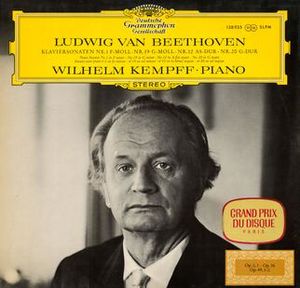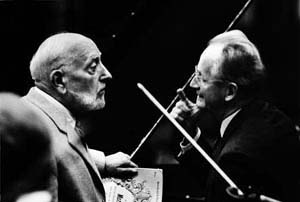Wilhelm Kempff facts for kids

Wilhelm Walter Friedrich Kempff (born on November 25, 1895 – died on May 23, 1991) was a famous German pianist and composer. He played music by many great composers like Bach, Mozart, and Chopin. But he was especially known for playing the music of Ludwig van Beethoven and Franz Schubert. He even recorded all the sonatas (long musical pieces) by both of these composers. Many people think he was one of the best pianists of his time and one of the greatest ever.
Contents
Early Life
Wilhelm Kempff was born in a town called Jüterbog in Germany in 1895. He grew up nearby in Potsdam. His father was a royal music director and played the organ at a church there. His grandfather was also an organist, and his brother became a church music director at a university.
Wilhelm started learning music from his father when he was very young. When he was nine, he went to the Berlin Hochschule für Musik. There, he studied how to compose music with Robert Kahn. He also learned piano from Karl Heinrich Barth, who taught another famous pianist, Arthur Rubinstein. In 1914, Kempff went to study at a school in Potsdam before finishing his training back in Berlin.
A Talented Pianist
In 1917, Kempff gave his first big concert. He played important pieces, including Beethoven's difficult Hammerklavier Sonata. Wilhelm Kempff traveled all over Europe and many other parts of the world to perform. From 1936 to 1979, he played in Japan ten times. A small Japanese island was even named Kenpu-san in his honor!
He first played in London in 1951 and in New York in 1964. His very last public performance was in Paris in 1981. After that, he stopped playing because of his health. He passed away in Positano, Italy, in 1991 when he was 95 years old. He had been married since 1926 and had seven children.
Wilhelm Kempff recorded music for about sixty years. He recorded works by many composers, but especially by Beethoven.

He recorded all of Franz Schubert's piano sonatas before they became very popular. He also recorded all of Beethoven's sonatas two times. Once in the 1950s and again in the 1960s. He also recorded all of Beethoven's piano concertos (pieces for piano and orchestra) twice. He played with the Berlin Philharmonic orchestra for these recordings. Kempff also played chamber music (music for a small group of instruments) with other famous musicians like Yehudi Menuhin and Pierre Fournier.
He made recordings of most of the music he played. He continued to perform concerts even after he turned eighty. He worked with the Berlin Philharmonic orchestra for over sixty years.
His Unique Style
When Kempff performed, he focused on making the music sound like it was singing. He wanted it to feel natural and spontaneous. He was especially good at playing quiet and personal pieces. He didn't play too fast or try to show off.
Another famous pianist, Alfred Brendel, said that Kempff played "on impulse." He meant that Kempff's playing depended on his feelings at that moment. Brendel also called Kempff the "most rhythmical" of his fellow pianists.
Once, when Kempff was in Finland, the composer Jean Sibelius asked him to play a slow part of Beethoven's 29th Sonata. After Kempff finished, Sibelius told him, "You did not play that as a pianist but rather as a human being." This shows how deeply Kempff connected with the music.
A Dedicated Teacher
From 1924 to 1929, Kempff was in charge of the Stuttgart College of Music. In 1931, he helped start summer music courses in Potsdam.
In 1957, Kempff started a special foundation called Fondazione Orfeo in Positano, Italy. He built a place called Casa Orfeo there. He held his first masterclass (a special lesson for advanced students) on Beethoven's music there. He continued to teach these classes once a year until 1982.
Many well-known pianists studied with Kempff. Some of them include Jörg Demus, Mitsuko Uchida, and Maria João Pires.
His Compositions
Wilhelm Kempff also composed music, though he is less known for this. He wrote music for almost every type of instrument and group. He even wrote his own special parts (called cadenzas) for Beethoven's first four Piano Concertos. One of his students, İdil Biret, recorded a CD of his piano music.
His second symphony (a long piece for orchestra) was first played in 1929 by the Leipzig Gewandhaus Orchestra. He also arranged some of Bach's music for piano. His opera (a musical play) called Famile Gozzi was a funny work he wrote in 1934.
During World War II
During World War II, Wilhelm Kempff performed many times. He played concerts in different places during this difficult period in history.
Important Recordings
Here are some of Wilhelm Kempff's many recordings:
- Beethoven: Piano Sonata No. 22. Also, Schubert: Piano Sonata D 845, op. 42. Plus, works by Rameau, François Couperin, Handel, and W. A. Mozart (released in 2013).
- Beethoven: Piano Sonatas Nos. 1, 12, 19, and 20 (DG LP 138 935). This recording came out in 1965 and won the Grand Prix du Disque award.
- Schubert: All of his Piano Sonatas (DG 463 766-2). These recordings were made between 1965 and 1970.
See also
 In Spanish: Wilhelm Kempff para niños
In Spanish: Wilhelm Kempff para niños

